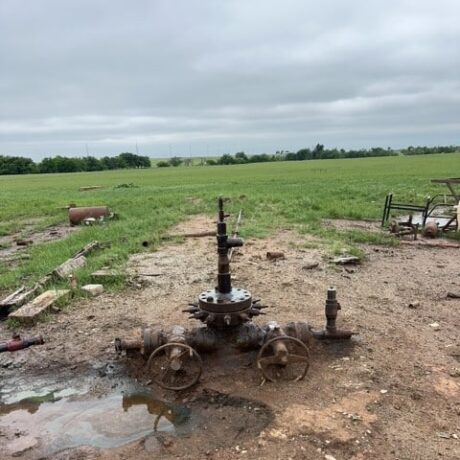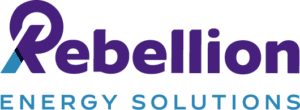The Situation
The Orphan Well Problem
An orphan well is an unplugged, inactive well with no solvent operator of record responsible for its maintenance or remediation. Orphan wells are considered “wards of the state” and are the responsibility of the government entity with regulatory authority. Because of this, many orphan wells are in a state of advanced disrepair, resulting in dangerous pollutant leaks into the air, degrading soil, damaging ecosystems, and posing a significant risk to human health and the well-being of surrounding communities.
According to the U.S. Department of the Interior millions of Americans across the country live within a mile of an orphaned oil and gas well. These legacy pollution sites are environmental hazards and jeopardize public health and safety by emitting noxious gases like methane, littering the landscape with rusted and dangerous equipment, and harming wildlife.
Methane is the second largest contributor to climate change, and its warming effect over the course of 20 years is 28 times greater than CO2, making it our top abatement priority. The scale of the methane-leaking, orphan well problem is enormous – according to the Environmental Defense Fund, the U.S. Environmental Protection Agency estimates millions of wells that need to be plugged, and millions of metric tons of CO2e leaking into the atmosphere each year.

The Rebellion Energy Solution
We focus on plugging orphan oil and gas wells and regenerating the surrounding land bases – abating methane emissions, restoring spoiled ecosystems and generating high-quality carbon credits as a result.
Step 1: Plug Orphan Wells
Our first step is to identify orphan wells and work with the landowners and communities they impact. We visit the site and evaluate the level of methane and other emissions to develop a comprehensive plugging and restoration process using The Rebellion Method sets intentionally high internal standards and includes a comprehensive Monitoring, Reporting, and Verification (MRV) Plan.
Step 2: Restore the Lands
In addition to plugging orphan wells to abate methane leaks, our team is focused on co-benefits of the land restoration process such as environmental and community benefits. When we regenerate the surrounding land bases, restoring spoiled ecosystems and returning the land to it’s original, natural state, we support several UN Sustainable Development Goals and partner with SnapLands to restore native prairie.
Step 3: Generate High-Quality Carbon Credits
Well-plugging and land restoration generates top-tier third-party endorsed credits issued by ACR using stringent methodology.
Buyers can be assured that when they purchase a methane-abatement credit from Rebellion, they are directly contributing to durable and impactful sustainability solutions for our global community.
Step 4: Funding Future Well-Plugging Projects
When individuals and organizations purchase our high-quality carbon credits, we are able to fund the plugging of additional orphan wells, generating additional top-tier carbon credits.
Back to step 1 and repeat the cycle of methane-abatement and carbon-credit generation.
Orphan Well & Carbon Credit FAQs
Orphan wells are unplugged and inactive wells that have no solvent operator of record. They are considered “wards of the state” and are the responsibility of the government entity with regulatory authority.
Because of this, many orphan wells are in a state of advanced disrepair, resulting in dangerous pollutant leaks into the air, contaminating groundwater, degrading soil, damaging ecosystems, and posing a significant risk to human health and the well-being of surrounding communities.
Carbon credits, broadly known as Environmental Attributes (EA), are a unit of exchange used to offset an entity’s carbon footprint. One (1) carbon credit equals one (1) metric ton of carbon or its equivalent (MTCO2e).
The voluntary carbon market (VCM) is growing rapidly across the globe as more companies make net zero commitments. In the voluntary carbon market, a carbon credit represents the reduction or removal of one metric ton of carbon dioxide (CO₂) or equivalent greenhouse gases. Investment in high-quality carbon projects allows companies to make a meaningful impact on their net zero goals while significantly contributing to the direct reduction of greenhouse gas emissions that would otherwise pollute the atmosphere.
A carbon project is an effort made by a group, the project developer, to reduce carbon in the atmosphere. A reputable carbon credit is an additive to the status quo, permanent, and verified by a reputable registry.
Methane is the second largest contributor to climate change, and its warming effect over the course of 20 years is 28 times greater than CO2, making it our top abatement priority. The scale of the methane-leaking, orphan well problem is enormous – according to the Environmental Defense Fund, the U.S. Environmental Protection Agency estimates millions of wells that need to be plugged, and millions of metric tons of CO2e leaking into the atmosphere each year.
Methane Abatement projects are those that can be applied across oil and gas value chains to reduce emissions.
Contact us directly by emailing landowners@rebellionenergy.com.
Co-benefits are ways to describe additional environmental and community benefits that arise from the original project. Co-benefits of the Rebellion method of plugging orphan oil and gas wells include environmental and community benefits such as regenerating the surrounding land bases, restoring spoiled ecosystems and returning the land to its original, natural state.
The 2030 Agenda for Sustainable Development, adopted by all United Nations Member States in 2015, provides a shared blueprint for peace and prosperity for people and the planet, now and into the future. At its heart are the 17 Sustainable Development Goals (SDGs), which are an urgent call for action by all countries – developed and developing – in a global partnership. They recognize that ending poverty and other deprivations must go hand-in-hand with strategies that improve health and education, reduce inequality, and spur economic growth – all while tackling climate change and working to preserve our oceans and forests.
The SDGs build on decades of work by countries and the UN, including the UN Department of Economic and Social Affairs
